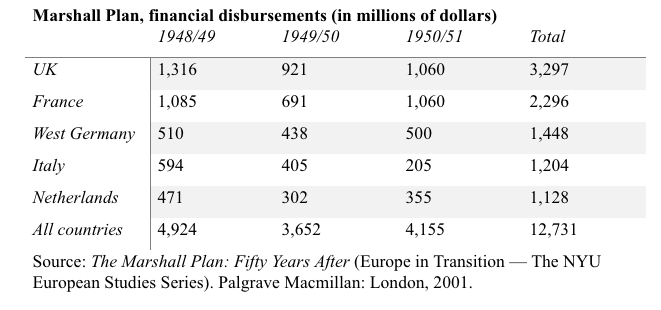The Marshall Plan: Fiction and Facts
Some myths never die. This is the case with the claim that massive financial transfers helped to rebuild Western Europe after the Second World War. Whenever there is an international problem, someone will show up and invoke the Marshall Plan as an argument in favor of financial transfers. This happened again when Mexico’s incoming foreign minister claimed that a scheme similar to the Marshall Plan would be necessary to handle the migrant crisis in Central America and Mexico. Despite the declarations that say the European economic recovery and West Germany’s economic miracle were the result of the monetary transfers of the Marshall Plan, the facts tell a different story. What counted was not the financial aid but the economic liberation that came with the plan.
Facts
The Marshall Plan was not the gigantic financial program that is so often invoked as an example to argue for providing mega funding for mitigating some issue. Given that large parts of Europe were destroyed and that the program was spread across 16 European countries, each country received just enough to keep its population free from starvation. Overall, $12.7 billion was spent under the Marshall Plan (see table), a sum that today would amount to about $130 billion. Of that amount, the largest part went to the United Kingdom (26 percent) and France (18 percent).
The share of West Germany was 11 percent, which did not compensate for the loss due to the dismantling of industries and the confiscation of patents, copyrights, and trademarks. The sum that West Germany received amounted to about 3 percent of its gross domestic product, which was then considerably below the pre-war period. For West Germany, the Marshall Plan amounted to $1,448 billion, which in today’s purchasing power amounts to approximately $15 billion.
The Marshall Plan specified that each recipient had to sign a bilateral pact with the United States that stipulated that the countries had to pursue balanced budgets, restore internal financial consolidation, and stabilize their exchange rates “at realistic levels.” Government intervention was discouraged, and the plan promoted European economic integration and thus prepared the European Payments Union of 1950 as precursor to the European Economic Community of 1957.
Most importantly, however, the Marshall Plan ended the “reverse Marshall Plan” of the first years after the end of the war — at least for West Germany.
The “Reverse Marshall Plan”
The Soviet Union was invited to join the Marshall Plan but refused to participate. Instead, the Soviets installed a “reverse Marshall Plan” and appropriated a value of about the same amount as the Marshall Plan in the form of physical reparations from those countries — all of Eastern Europe — that came under Soviet rule after Churchill and Roosevelt had handed over to Stalin. Poland’s borders were pushed westward as it acquired German territory to make space for the Russians.
A Soviet directive led the former German lands to be ethnically cleansed so that between 1945 and 1950, Europe witnessed the largest episode of forced migration and perhaps the single largest movement of population in human history when between 12 and 14 million German-speaking civilians (mostly women, old people, and children) were forcibly ejected from their places of birth and heritage. Sadly enough, the Poles, Czechs, Romanians, Hungarians, and other peoples of Eastern Europe who fell under Soviet dictatorship experienced their own kind of misery under Communist slavery for the next half century.
This directive, which was inspired by the Morgenthau Plan elaborated in the Treasury during the Roosevelt presidency, foresaw an almost complete deindustrialization of Germany with the consequence of an estimated annihilation of around 25 million people.
In July 1947, with the advent of the initial planning for the Marshall Plan (designed to foster a European economic recovery), the restrictions were lessened and U.S. occupation directive JCS 1067, whose economic section had prohibited any “‘steps looking toward the economic rehabilitation of Germany” or “to maintain or strengthen the German economy,” was replaced by the new U.S. occupation directive JCS 1779 directive, which instead stated that “an orderly, prosperous Europe requires the economic contributions of a stable and productive Germany.”
With the start of the Cold War, the United States identified the Soviet Union as its new enemy and accepted that without a German economic recovery there would be no prosperity in Europe and thus it would be only a matter of time until Western Europe, too, would fall under the dominance of the Soviet Union.
Economic Liberalization
The financial part of the Marshall plan was not the decisive factor in the West European recovery. What mattered was economic liberalization, relative monetary and fiscal stability, and the promotion of economic integration. It was not the financial flows per se, but the conditions attached to the Marshall Plan that were decisive for the European recovery: economic liberalization and integration, and free trade.
Those countries that received the most aid did not grow more rapidly than those countries that received fewer funds, such as West Germany. The first delivery of U.S. goods prevented mass starvation, yet some aid was problematic, as when, for example, instead of farm equipment, the United States delivered tobacco and when it helped Britain and France to acquire military equipment to continue their colonial wars against independence movements in Africa and Asia.
The essential contribution of the Marshall Plan was to do away with regime uncertainty. More important than financial aid was the restoration of business confidence. What mattered was the belief that investment would pay off, that in the face of absolute destitution and destruction, the marginal investment would render high returns. For the German people, the Marshall Plan cast away the fear of being pushed into poverty forever and instead lit the light of hope for prosperity. In other words, the conditions of the Marshall Plan — in combination with the internal reforms by West Germany’s minister of the economy, Ludwig Erhard — liberated the entrepreneurial spirit and launched the so-called German economic miracle.
The lesson of the Marshall Plan for solving the current migrant crisis at the U.S.-Mexican border is not that more financial transfers to Latin America are needed, despite what the Mexican minister pronounced. Instead of more money, the poor countries must implement domestic economic reforms that do away with state interventionism, corruption, and clientelism and liberate the economy from the yoke of bureaucracy and cumbersome taxation.
The underlying reason for migration is the productivity gap. If, for example, a company from an industrialized country sets up a factory in an emerging economy, its output will not reach the same productivity level as at home. Yet if workers from a developing country begin to work in a developed country, their productivity will rise almost overnight and so will their wages. What counts for labor productivity is the business environment, which includes many aspects of governance. Instead of demanding transfers, the developing countries must facilitate doing business. If this were done, the flows of capital from private sources would create well-paying jobs in these countries and the need to emigrate would fade.
Conclusion
Western Europe received American aid from the Marshall Plan from 1948 until 1952. Starting in these years, many countries of Western Europe experienced a strong economic recovery, particularly the Federal Republic of Germany, which experienced the so-called German economic miracle. Contrary to legend, the real lesson of the Marshall Plan is not to try to benefit countries through financial transfers for recovery from war and crises but to promote pro-market economic reforms. What made the Marshall Plan a success were the conditions attached to it. The only countries that could obtain the aid that concluded a pact with the United States were those that met the conditions of monetary and fiscal stability, economic integration, and free trade. The lesson of the Marshall Plan is economic liberalization and doing away with regime uncertainty.












